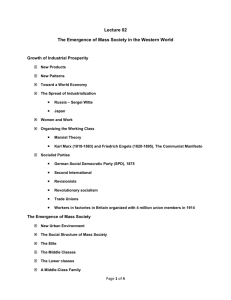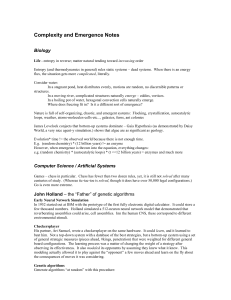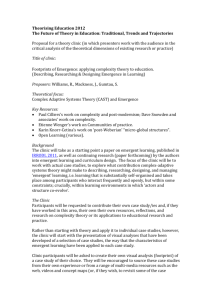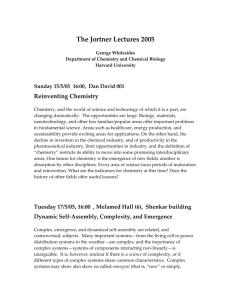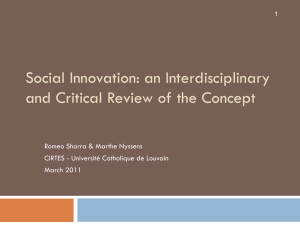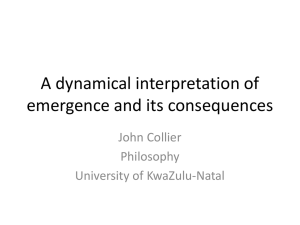Tesfatsion, Leigh (2002). Agent
advertisement
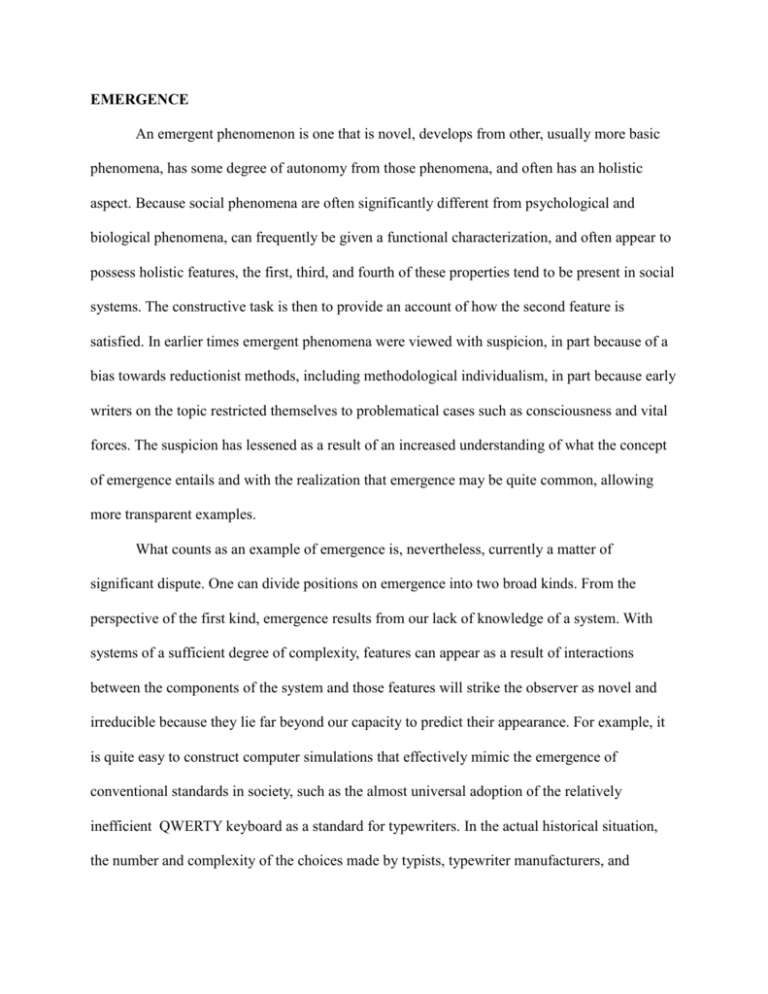
EMERGENCE An emergent phenomenon is one that is novel, develops from other, usually more basic phenomena, has some degree of autonomy from those phenomena, and often has an holistic aspect. Because social phenomena are often significantly different from psychological and biological phenomena, can frequently be given a functional characterization, and often appear to possess holistic features, the first, third, and fourth of these properties tend to be present in social systems. The constructive task is then to provide an account of how the second feature is satisfied. In earlier times emergent phenomena were viewed with suspicion, in part because of a bias towards reductionist methods, including methodological individualism, in part because early writers on the topic restricted themselves to problematical cases such as consciousness and vital forces. The suspicion has lessened as a result of an increased understanding of what the concept of emergence entails and with the realization that emergence may be quite common, allowing more transparent examples. What counts as an example of emergence is, nevertheless, currently a matter of significant dispute. One can divide positions on emergence into two broad kinds. From the perspective of the first kind, emergence results from our lack of knowledge of a system. With systems of a sufficient degree of complexity, features can appear as a result of interactions between the components of the system and those features will strike the observer as novel and irreducible because they lie far beyond our capacity to predict their appearance. For example, it is quite easy to construct computer simulations that effectively mimic the emergence of conventional standards in society, such as the almost universal adoption of the relatively inefficient QWERTY keyboard as a standard for typewriters. In the actual historical situation, the number and complexity of the choices made by typists, typewriter manufacturers, and businesses precluded both prediction of the emergence of this standard and its explanation via the decomposition strategies that are often successful in giving us understanding in less complex systems. Some versions of this unpredictability approach suggest that it is impossible in principle to predict emergent features, although because predictability is relative to the theory used for prediction, and an unpredictability claim can be trivially undermined by adding the sentence to be predicted, such claims are rarely both precise and convincing. One reasonable interpretation of what is intended, however, is that the novel state of affairs could have been known only by waiting until it first appeared, even in the simulation model. These approaches using unpredictability fall into the category of what is often called weak emergence – weak because there is no commitment to downward causation, only to the existence of certain stable patterns in society. What is in contrast often called strong emergence has a robustly ontological commitment; something genuinely new has emerged in the social world beyond what was in the elements from which the whole was constructed. It is strong emergence that has traditionally been the source of disputes in the social sciences. Those who subscribe to some form of individualism – the position that only individuals and their properties exist – hold that not only do individuals pre-exist social arrangements, both temporally and ontologically, but that there is nothing over and above individuals, their properties, and relations between individuals. Strong emergentists deny this and argue that there is more to the systems than individuals and their properties but tend to differ on what more there is. Some allow that there are social properties in addition to individual properties; others that higher order entities such as corporations and universities exist in addition to their members; others that individuals play no essential role in social processes and that all identifiably social causation occurs at the social level; and still others hold that there are emergent social laws that govern the development of social units or of individuals. Within the individualist camp, the status of social relations is the subject of discussion. For some, such relations can be completely reduced to or supervene on intrinsic properties; in the latter case, once the intrinsic properties have been fixed, the social relations are automatically determined. For others, these social relations are sui generis and constrain the individuals that they relate, often by influencing the agents’ beliefs. It is widely believed that the supervenience position precludes downward causation and hence strong emergence, because any influence from downward causation would be redundant given the causal processes at the level of individuals. But there is less reason to think that the realm of intentional action by individuals is causally closed in the way that the physical realm might be closed, and so this application of the causal exclusion argument is not completely convincing. Many anti-individualist positions can sensibly be called emergentist positions and even individualist positions allow for weakly emergent features. Despite this, one must be aware that much talk of emergence in the social science literature is a façon de parler and does not reflect the existence of emergence in the strong sense. It is commonly held amongst weak emergentists that emergence occurs when a threshold of complexity is crossed in a system. Investigations of this sort of emergence have been aided by the development of agent based models. The constituent elements of these models are individuals, but in virtue of allowing multiple iterations of usually pairwise and often non-linear interactions between large numbers of agents, the emergence of novel structures or equilibria is sometimes observed. A well-known early example of this type of model was Thomas Schelling’s toy model of social segregation which demonstrated that small preferences about one’s type of neighbor can lead to structures of segregation in the society as a whole. These models have great potential in sociology, anthropology and microeconomics, although they have not been welcomed by all, especially those who work in traditional economics. Such simulations support one version of weak emergence in which the only way to know how the system will evolve is to let the system run its course or to simulate its microstates. This computational incompressibility gives some precision to unpredictability but it is important to maintain a separation between emergent phenomena occurring in computer simulations of societies and the related phenomena occurring in the societies themselves. One consequence of our inability to predict the dynamics of complex systems on the basis of micro-information alone is the introduction of a macro-level vocabulary that is conceptually different from the micro-level descriptions and which facilitates prediction and description in virtue of erasing many of the details of the micro-states. This is why the vocabularies of microeconomics and of macroeconomics differ, as do the vocabularies of cognitive psychology and sociology, and of sociobiology and anthropology. A common position holds that emergence entails the impossibility of reduction, although this incompatibility is occasionally resisted. This tradition requires that a hierarchy of levels or domains be identified in order for one level or domain to be reduced to or emerge from another. The usual ordering of levels based on composition, in which a necessary condition for one entity to exist at a higher level than another is that the latter be a constituent of the former, breaks down for the social sciences. Prima facie, one could argue that a particular type of economic system emerged from a set of cultural norms in a society, but neither economic processes nor cultural norms are constituents of one another. A possible source of confusion also needs to be addressed. It is sometimes claimed that B's being explained in terms of A entails that B has been reduced to A. In certain cases, such as theoretical explanation, this makes sense but in other cases such as ontological explanations, this is straightforwardly false, as can be seen in the case when A is the cause of B, and the claim relating explanation and reduction seems to presuppose the presence of inter-level explanations. A second broad division in emergence is that between synchronic and diachronic emergence. Although the majority of the philosophical literature on emergence addresses the synchronic case, the role of history in social institutions suggests the need to examine diachronic emergence more closely. Path dependence is a common phenomenon in the development of societies and social institutions, and synchronic emergence is unable to address this feature. It is the ability to computationally model the dynamics of social systems that has led to an increased acceptance of the existence of dynamically emergent social features. Social Facts The taxonomy given above makes no reference to rationality, intentionality, cultural norms, or other special features of human agency, whereas the existence of some emergent features of social groups seems to depend upon the specifically social and normative aspects of social systems. The most prominent of these types of claims is Emile Durkheim’s view that social facts exist, either as concrete institutions or as social norms, but social cooperation, group intentionality, and collective agency have been the focus of research in recent years. A core topic in this area is the emergence of cooperative behavior in societies, in particular the problem of how self-interested individuals can maintain a stable, cohesive, and efficient society. In this and other cases normative criteria, especially those related to rationality, must frequently be taken into account. Some approaches in this area are reductive and neither require nor entail emergent features but many are committed, via an irreducible appeal to first person plural perspectives -`We endorse the candidate’ can be true even if some individuals in the group voted against that candidate – to, at least, representations of collective social phenomena. Social interaction often involves representations, hence it presents the difficult philosophical problem of intentionality in ways that examples of physical emergence do not. To this end, John Searle has argued that collective intentionality resulting in linguistic declarations can lead to social facts such as the establishment of a corporation, which may or may not be followed by the existence of an entity, the concrete corporation. Although much of this literature concerns group agency, and hence the question of whether the group acts rationally on at least some occasions, there is an ontological aspect of this issue, which is whether social agents emerge from the interactions of individuals and exist autonomously from those individuals. For example, there is a long tradition within United States law of treating corporations as individuals. Whether or not this is legally or morally correct, one reason to think that some organizations are autonomous is the fact that group agents such as corporations and universities can retain their identities and ability to act despite complete replacement of the individuals that work in them. Mechanisms of self-organization can help us understand how certain types of groups can act cooperatively and in Niklaus Luhmann’s work, it is this combination of self-organization (autopoiesis) and the independence of such features as economic patterns from the individuals that instantiate them that is characteristic of social systems. Despite the increased availability of tools to represent emergent features in social systems, it is important to maintain reductive individualism as the default position and to postulate emergent phenomena only when there is no convincing alternative position available. Unless one adopts this methodological position, introducing emergent entities becomes an escape route that is too easily available to avoid the difficult work of constructing a plausible individualist explanation. Paul Humphreys University of Virginia See also Agent-Based Modeling and Simulation in the Social Sciences, Collective Agents, Emergence and Social Collectivism, Holism, in Social Sciences, Individualism (Methodological), Reductionism in the Social Sciences. FURTHER READINGS Bedau, Mark and Paul Humphreys (Eds) (2008). Emergence: Contemporary Readings in Philosophy and Science. Cambridge: The MIT Press. List, Christian and Philip Pettit (2011). Group Agency: The Possibility, Design, and Status of Corporate Agents. New York: Oxford University Press. Sawyer, R. Keith (2005). Social Emergence: Societies as Complex Systems. Cambridge: Cambridge University Press. Searle, John (1995). The Construction of Social Reality. New York: The Free Press. Tesfatsion, Leigh (2002). Agent-Based Computational Economics: Growing Economies From the Bottom Up. Artificial Life 8, 55-82. Tuomela, Raimo (2002). The Philosophy of Social Practices: A Collective Acceptance View. Cambridge: Cambridge University Press.
